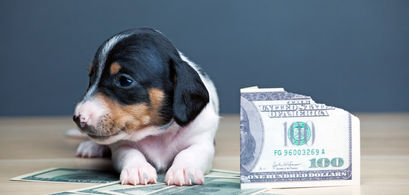Dogs of the Dow theory, used as an investment strategy, was first popularized by Michael O'Higgins in his book Beating the Dow, which was published back in 1992. The theory is based on the purchase of high dividend yield stocks that are members of the Dow Jones Industrial Average. This concept is a great follow up to our article on dividend paying stocks, where we explain why certain companies pay higher dividends than others. The term "dogs" refers to the fact these companies have somehow fallen out of favor with the investment community.
Dogs of the Dow Theory
The approach behind this investment method is simple. The Dow Jones Industrials is a prestigious list of 30 blue chip stocks. Sorting these stocks to find the ten companies with the highest dividend yield will produce a list of companies that are undervalued relative to their peers. By refreshing the list each year, there is a chance that new "dogs" will be picked. These are the stocks that stand the greatest opportunity to catch up with their peers, thereby outperforming the DJIA. O'Higgins examined their performance by looking at the annual returns of these sets of stocks over a 17-year timeframe. He compared the performance of a portfolio of ten stocks with that of the rest of the Industrials Index. He found the average annual return for the Dogs of the Dow was 17.9%, compared to 11.1% for the rest of the Dow. To summarize, in this theory we have a combination of large cap stocks, paying high dividend yields, which seem to be undervalued relative to their peers.
Choosing the Dogs of the Dow
Each year, a new portfolio of stocks is chosen, using the closing price on the last day of trading for the previous year. Some of the stocks might remain the same; some companies will be replaced by new dogs. Investors purchasing this portfolio are supposed to allocate 10% of their investment dollars to each stock. This means a different number of shares for each company are bought, since their market prices will be different. Fortunately, several mutual funds have responded to the popularity of this investment strategy, and it's possible to purchase mutual funds that follow the Dogs of the Dow Theory.
The term "dogs" refers to the fact these companies have somehow fallen out of favour with the investment communityMoneyzine Editor
Recent Returns
In recent years, the performance of these dogs has not fared quite as well as the time period examine by O'Higgins (1973 to 1989). For example, they’ve only beaten the S&P 500 Index three times in the last five years. The dogs have also been outpaced by the Dow Jones Industrial Average three times in the last five years. Below is a table illustrating the relative performance of this group for the years 2000 through 2020.
Historical Performance
Year | Dogs | DJIA | S&P 500 |
2020 | -12.6% | 7.2% | 18.4% |
2019 | 15.5% | 22.3% | 31.5% |
2018 | 0.0% | -3.7% | -4.6% |
2017 | 19.4% | 25.1% | 18.9% |
2016 | 16.1% | 13.4% | 9.5% |
2015 | -1.2% | -2.2% | -0.9% |
2014 | 7.0% | 7.5% | 11.4% |
2013 | 30.3% | 28.1% | 31.8% |
2012 | 5.7% | 7.3% | 13.4% |
2011 | 12.2% | 5.5% | 0.0% |
2010 | 15.5% | 11.0% | 12.8% |
2009 | 12.9% | 18.8% | 23.5% |
2008 | -41.6% | -33.5% | -38.5% |
2007 | -1.4% | 6.4% | 3.5% |
2006 | 30.3% | 19.1% | 15.8% |
2005 | -5.1% | 1.7% | 4.9% |
2004 | 4.4% | 5.3% | 10.9% |
2003 | 28.7% | 28.3% | 28.7% |
2002 | -8.9% | -15.0% | -22.1% |
2001 | -4.9% | -5.4% | -11.9% |
2000 | 6.4% | -4.7% | -9.2% |
The above table demonstrates that 2020 was a bad year for this group. The Dogs of the Dow were outpaced by both the S&P 500 and the DJIA.
Dogs of the Dow Portfolios
Now that we've explained the investment theory, and provided information on relative performance, it's time to share the Dogs of the Dow for 2021. Remember, this list is based on the closing performance for 2020. The next group of stocks will be published after the last trading day of the year. For reference, we've listed below the Dogs of the Dow for the last five years.
Dogs of the Dow 2021
Stock Symbol | Company Name | 2020 Close | Dividend Yield |
CVX | Chevron | 84.45 | 6.11% |
IBM | International Business Machines | 125.88 | 5.18% |
DOW | Dow | 55.5 | 5.05% |
WBA | Walgreens | 39.88 | 4.69% |
VZ | Verizon | 58.75 | 4.27% |
MMM | 3M | 174.79 | 3.36% |
CSCO | Cisco | 44.39 | 3.24% |
MRK | Merck | 81.8 | 3.18% |
AMGN | Amgen | 229.92 | 3.06% |
KO | Coca-Cola | 54.84 | 2.99% |
Dogs of the Dow 2020
Stock Symbol | Company Name | 2019 Close | Dividend Yield |
DOW | Dow | 54.73 | 5.12% |
XOM | ExxonMobil | 69.78 | 4.99% |
IBM | International Business Machines | 134.04 | 4.83% |
VZ | Verizon | 61.4 | 4.01% |
CVX | Chevron | 120.51 | 3.95% |
PFE | Pfizer | 39.18 | 3.88% |
MMM | 3M | 176.42 | 3.26% |
WBA | Walgreens | 58.96 | 3.10% |
CSCO | Cisco | 47.96 | 2.92% |
KO | Coca-Cola | 55.35 | 2.89% |
Dogs of the Dow 2019
Stock Symbol | Company Name | 2018 Close | Dividend Yield |
IBM | International Business Machines | 113.67 | 5.52% |
XOM | ExxonMobil | 68.19 | 4.81% |
VZ | Verizon Communications | 56.22 | 4.29% |
CVX | Chevron | 108.79 | 4.12% |
PFE | Pfizer | 43.65 | 3.30% |
KO | Coca-Cola | 47.35 | 3.29% |
JPM | JP Morgan Chase | 97.62 | 3.28% |
PG | Procter & Gamble | 91.92 | 3.12% |
CSCO | Cisco Systems | 43.33 | 3.05% |
MRK | Merck | 76.41 | 2.88% |
Dogs of the Dow 2018
Stock Symbol | Company Name | 2017 Close | Dividend Yield |
VZ | Verizon Communications | 52.93 | 4.46% |
IBM | International Business Machines | 153.42 | 3.91% |
PFE | Pfizer | 36.22 | 3.75% |
XOM | ExxonMobil | 83.64 | 3.68% |
CVX | Chevron | 125.19 | 3.45% |
MRK | Merck | 56.27 | 3.41% |
KO | Coca-Cola | 45.88 | 3.23% |
CSCO | Cisco Systems | 38.3 | 3.03% |
PG | Procter & Gamble | 91.88 | 3.00% |
GE | General Electric | 17.45 | 2.75% |
Dogs of the Dow 2017
Stock Symbol | Company Name | 2016 Close | Dividend Yield |
VZ | Verizon Communications | 53.38 | 4.33% |
PFE | Pfizer | 32.48 | 3.94% |
CVX | Chevron | 117.7 | 3.65% |
CSCO | Cisco Systems | 30.22 | 3.44% |
BA | Boeing | 155.68 | 3.65% |
KO | Coca-Cola | 41.46 | 3.38% |
IBM | International Business Machines | 165.99 | 3.37% |
XOM | ExxonMobil | 90.26 | 3.32% |
CAT | Caterpillar | 92.74 | 3.32% |
MRK | Merck | 58.87 | 3.19% |


